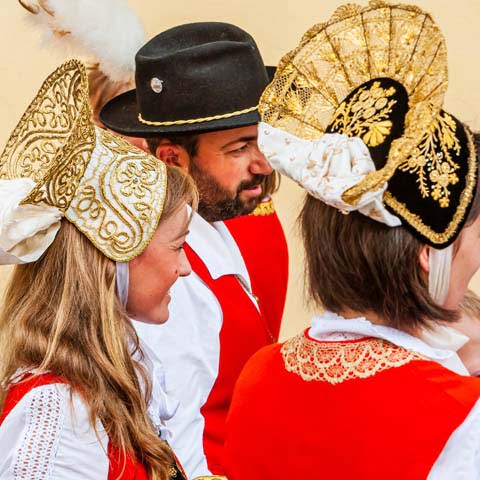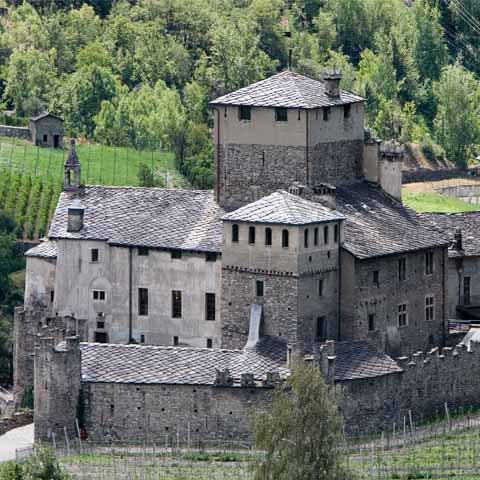Nestled in the basin of the Aosta Valley in Northern Italy, the capital city of Aosta is characterized by its rich history.
During Roman times it served as a connecting point between two of the world’s most important trade routes – those that linked France and Italy. Romans saw the value in settling in Aosta and built a garrison there. Today, the Roman structure of the city’s roads and the many Roman ruins and architectural remnants that are left behind help shape the city into the historic locale that it is.
Throughout the rest of Aosta’s history, it was bounced between several world powers – including France and Italy – making the culture of the city varied and unique. From bilingual residents with a unique local dialect to a rich and hearty cuisine reflective of the city’s mountainous upbringings – the Valdostan culture defines Aosta as a one of kind destination, completely different than anything one might find throughout Italy’s other top destinations.
Although the ancient ruins and gray-toned architecture throughout the city give it an antique feeling, Aosta is growing in modern times, attracting more residents each year with its unique culture. Due to the city’s rich history and multicultural roots, traveling in Aosta is almost like taking a tour through time – from prehistoric eras to the modern day.
ART
The city of Aosta and its mountainous backdrop created by the stunning Italian Alps could, in itself, be viewed as a work of art. The stunning views, ancient Roman architecture, and Medieval castles are the city’s main attraction.
Because Aosta was an important Roman settlement, a must-see for any traveler visiting Aosta are its many Roman ruins. One of the town’s main symbols is the Roman Arch of Augustus. Built in 25 BC, it was meant to commemorate the Roman victory over the Salassi tribe and pay tribute to Augustus. Another relic from the same time is the Pretorian Gate – the largest monument from the time period, it is strikingly well-preserved. Perhaps the most interesting Roman architecture in Aosta is located in the town’s Roman Forum – once the center of social, political, and religious life in ancient Rome. The Criptoportico Forense is one of the city’s most intriguing sites, as it is completely underground and supported by a series of arches and columns.
Not far from the Roman Forum is the Cathedral of Santa Maria Assunta e San Giovanni Battista – the best location to view Christian art in the city and a wonderful depiction of ancient architecture. Built in the eleventh century, the cathedral features incredible bell towers, Romanesque frescoes, historic decor, and more. In the fifteenth century, it was rebuilt, resulting in its Gothic and Renaissance features. Held within the Cathedral is the Museum of Treasure, which houses important artistic pieces of the Aosta Valley from the thirteenth to eighteenth centuries.
The fifteenth century Chapel of San Grato is home to a unique sixteenth century fresco by Malcastia, which is one of the few examples of art in Aosta from that period. Though today the chapel is deconsecrated, it is now used as a venue for local art exhibitions.
The Centre Saint Benin, whose structure dates back to the eleventh century, hosts a variety of modern and contemporary art exhibitions in the College of Higher Studies Chapel throughout the year. On display are works by national and international artists. Temporary art exhibitions can also be admired at the Hôtel des États Exhibition Venue.
ARCHITECTURE
Throughout the city and in the surrounding areas, travelers can also admire various medieval towers and historic castles. Set against the towering Italian Alps, these castles are as storybook-like as they are filled with rich history. A few of these remarkable castles include the Gothic Castello di Fénis, the nineteenth century Forte di Bard, and the twentieth century Castel Savoia with its remarkable Alpine Botanical Garden.
Among the religious buildings, the Church of Sant’Orso is one of the most revered local structures, in addition to the Cathedral. The original church dates back to the tenth century, but it was renovated in the fifteenth century resulting in the mixture of Romanesque and Gothic architectural elements that can be observed today. The bell tower, constructed in the Romanesque style, reaches a height of approximately 145 feet. Inside, the church hosts the relics of Saint Ursus of Aosta.
Another key church in Aosta is the Chuch of Santo Stefano. The site of the current church once hosted a fifteenth century church that was eventually rebuilt during the eighteenth century. The current façade of the church features a plain background with several frescoes that were restored at the beginning of the twenty-first century. Inside, the church features a Baroque altar as well as a large wooden statue of Saint Christopher.
Also of interest is the Church of Santa Croce, which was constructed towards the end of the seventeenth century. The frescoed façade features trompe-l’œil columns as well as a scene depicting the discovery of Christ’s Cross by Saint Helena, the mother of Constantine I. The interior features decorations from the seventeenth to the nineteenth centuries, and the church is often used as a venue for concerts.
In terms of civic monuments, the Bridge of Grand Arvou attests to Aosta’s medieval period. The bridge consists of one arch and served as an aqueduct. The structure of the bridge features a flagstone-covered roof, which differentiates it from other bridges and aqueducts in the area.
LITERATURE
Though he was not born in Aosta, French writer Xavier de Maistre and his family spent several years in the city, which served as a source of inspiration for Maistre’s writings. In fact, one of Maistre’s works is the novel The Leper from Aosta. Published in 1811, the novel features a leper who recounts stories about his secluded life to a soldier.
MUSIC
As with any region, music is one of the best ways to experience local culture as it tends to reflect the area’s history and tradition. The Aosta Valley is no exception. Throughout the region, including the city of Aosta, local music and dance groups utilize music to express their cultural heritage, which is a blend of Italian, French, Swiss, and Roman. Music throughout the Aosta Valley reflects this unique multicultural makeup by showcasing the various languages of the region – French, Italian, and the local dialect of Valdôtain. From traditional choral music to small local bands to folk music, the music of Aosta is as varied and multicultural as its history.
Aosta is also home to the Youth Symphony and the Orchestre d’harmonie du Val d’Aoste, which gives an annual New Year’s Eve concert.
SCIENCE
For travelers interested in science, Aosta’s Regional Archeological Museum is a great place to explore the history of the area’s early settlers and their way of life. It contains a collection of artifacts and pieces that range from prehistoric times to the Middle Ages.
Not far from Aosta is the Astronomical Observatory of the Autonomous Region of the Aosta Valley (OAVdA) – the only astronomical observatory in the country, which has established a long-term agreement with the INAF (Italian National Astrophysics Institute). The OAVdA is committed to providing the INAF with tools for research, education, and teaching. The OAVdA is also home to a planetarium at which travelers can experience once in a lifetime views of the night sky. Thanks to Aosta’s high altitude location and often clear weather, it is the perfect place to gaze at the night sky.
CINEMA
The stunning scenery of the Aosta Valley – with its towering mountains and lush forests – is nothing short of cinematic. So, it comes as no surprise that the area is a popular shooting location for films. In fact, the historic Forte di Bard, located approximately 30 miles from the city of Aosta, was used as a location for the popular film Avengers: Age of Ultron (2015).
Other movies filmed in the Aosta Valley include Quelli della montagna (1943), Il mio West (1998), Kingsman: The Golden Circle (2017), L’incredibile storia dell’Isola delle Rose (2020), and Diabolik (2021).
The city of Aosta, together with the surrounding region, is an area filled with history and culture. Characterized by Roman ruins, picturesque castles, and remarkable art museums, Aosta offers plenty of cultural activities to its visitors.
Travel Guides
The Aosta Valley Region of Italy
The Cities of Aosta Valley, Italy






